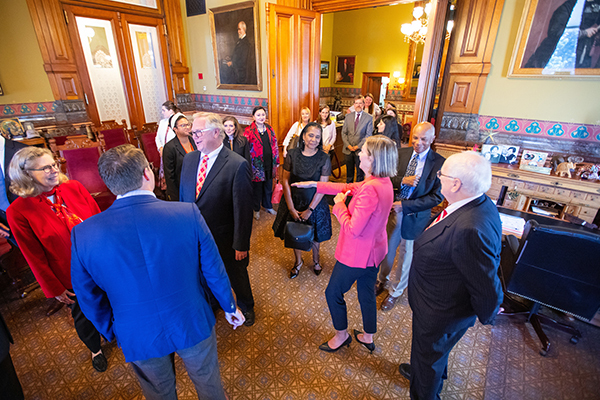The Public Service Loan Forgiveness (PSLF) program is getting easier to access under temporary rule changes enacted last fall. Some guidance still helps, though.
Through early May, about 127,000 applicants have successfully used the limited-time waiver of some of the strict regulations that have hampered PSLF, a federal program designed to forgive student loan debt for full-time workers after 10 years in a government job. That's a big spike that includes 1,620 Iowa borrowers who have eliminated a combined $73.3 million in debt, according to U.S. Department of Education data. In the four years borrowers could apply before the waiver, fewer than 20,000 were approved due to a rejection rate of about 98%.
But even under the waiver rules, about half of PSLF applications have been rejected, said Lindsay Clark, director of external affairs for Savi, a TIAA-run student loan repayment assistance service offered to Iowa State faculty and staff. Processing times also have been slow, with backlogs often running longer than three months.
"Good policy is one thing, but actual implementation is another," Clark said in a recent online briefing.
Most of the rejected applications should not have been denied and were later accepted, she said. That's what makes Savi a valuable resource even with the PSLF waiver, said Ed Holland, director of benefits and WorkLife for university human resources.
"Going it alone is not in an employee's best interest, and Savi is a great tool to help navigate the process," Holland said.
What ISU employees are saving
Savi, available to benefits-eligible ISU employees since June 2021, sorts through more than 150 state and federal assistance options to propose personalized repayment and forgiveness plans based on income, family size, debt amount and employment history.
At the free "DIY" level, employees receive links to the forms needed to apply for the recommended programs and take it from there themselves. At the "essential services" level, which costs $60 per year, Savi acts as a concierge, processing all the application forms, employer verifications and annual recertifications. Essential services clients also receive ongoing monitoring and one-on-one customer support.
In its first year, 204 ISU employees holding a combined $9.4 million in student loan debt registered with Savi, including 54 premium users. ISU participants lowered their projected monthly student loan payment by $161, on average. (As part of the response to COVID-19, repayment of most federal student loans has been paused since March 2020. The pause is set to expire Aug. 31, though it has been extended six times.)
Based on completed plans created by Savi, ISU employees using the service will see a projected average of $25,506 in loan forgiveness, a total of nearly $2.5 million.
Employees can sign up for Savi online any time and don't need to be a TIAA client. For a commitment-free assessment, employees need to supply their social security number, the first page of their most recent tax return and login information for any loan servicing companies they are using. For more information, consider joining one of Savi's twice-monthly online student loan forgiveness workshops. Upcoming workshops are June 15 at 11 a.m. and June 29 at 1 p.m.
What's in the waiver?
PSLF is one of the most common forgiveness options Savi recommends. The PSLF temporary waiver for some of the program's intricate rules runs through Oct. 31 and is allowed under emergency rules due to the pandemic. It could eliminate up to $4 billion in student loan debt nationwide, according to Department of Education estimates.
For applications filed by Oct. 31, past periods of repayment count toward the required 120 months even if the loan type or repayment plan would usually run afoul of PSLF rules. For example:
- PSLF applicants with loans through the Federal Family Education Loan (FFEL) and Federal Perkins Loan programs typically receive credit only for payments made after consolidating into a Direct Consolidation Loan. The waiver allows pre-consolidation payments toward FFEL and Perkins loans to count for PSLF. Applicants are still required to consolidate into a Direct Loan before applying for forgiveness.
- Every month in a repayment plan counts toward the 120-month requirement, even if the borrower paid late, paid less than the amount due or didn't make a payment that month.
- The temporary change to the payment rules means that borrowers whose federal student loan payments have been suspended during the pandemic can receive PSLF credit for repayment during those months -- which could account for about one-quarter of the 120 required months, if payments begin again in September as currently planned.
- Forbearance periods of 12 or more consecutive months or 36 or more cumulative months will count toward the 120-month mark, as will some deferment periods. In-school deferments and months when a loan has been in default will not count.
The waiver doesn’t change what sort of employment qualifies a borrower for the forgiveness program. Applicants still must have worked at least 30 hours per week for the government or a nonprofit that is tax-exempt under section 501(c)(3) of the Internal Revenue Code, which includes most private schools.
However, there is one change for applications submitted during the waiver period. Applicants will be eligible even if they're not working for a qualified employer at the time of the application or when their debt is eventually forgiven. Program rules usually require applicants to be employed at a qualifying job both at the time they apply and when forgiveness is granted.
For more details on the waiver rules, see the PSLF waiver website.

